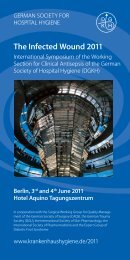Anforderungen an die Hygiene bei der Auf - Deutsche Gesellschaft ...
Anforderungen an die Hygiene bei der Auf - Deutsche Gesellschaft ...
Anforderungen an die Hygiene bei der Auf - Deutsche Gesellschaft ...
Sie wollen auch ein ePaper? Erhöhen Sie die Reichweite Ihrer Titel.
YUMPU macht aus Druck-PDFs automatisch weboptimierte ePaper, die Google liebt.
7<br />
Empfehlung <strong>der</strong> Kommission für Kr<strong>an</strong>kenhaushygiene und Infektionsprävention <strong>bei</strong>m Robert Koch-Institut (RKI)<br />
Recommendation of the Commission for Hospital <strong>Hygiene</strong> <strong>an</strong>d Infection Prevention at the Robert Koch Institute (RKI)<br />
kopie“ [Weiterbildungsempfehlung <strong>der</strong> <strong>Deutsche</strong>n<br />
Kr<strong>an</strong>kenhausgesellschaft (DKG)] besitzen [72]. Für<br />
endoskopisch tätige Mitar<strong>bei</strong>ter aus Praxen bietet<br />
sich <strong>die</strong> Schwerpunktfortbildung „Gastroenterologische<br />
Endoskopie für Arzthelferinnen“ <strong>an</strong> [siehe<br />
<strong>die</strong> Empfehlungen verschiedener L<strong>an</strong>desärztekammern<br />
(LÄK) und <strong>der</strong> Bundesärztekammer (BÄK)].<br />
• Regelmäßige hygienische und fachspezifische Schulungen<br />
aller in einer ambul<strong>an</strong>ten o<strong>der</strong> stationären<br />
Endoskopieeinheit tätigen Mitar<strong>bei</strong>ter sind nach MP<br />
BetreibV § 2 [127], BioStoffV § 12 und im Rahmen<br />
<strong>der</strong> UVV § 12 erfor<strong>der</strong>lich und zu dokumentieren<br />
(Kategorie IV).<br />
• Gemäß § 36 des Infektionsschutzgesetzes (IfSG)<br />
sind <strong>die</strong> innerbetrieblichen Verfahrensweisen zur<br />
Infektionshygiene in <strong>Hygiene</strong>plänen festzulegen<br />
(Kategorie IV).<br />
• Eine enge Zusammenar<strong>bei</strong>t mit <strong>Hygiene</strong>fachpersonal<br />
(z. B. Kr<strong>an</strong>kenhaushygieniker, <strong>Hygiene</strong>fachkraft,<br />
hygienebeauftragter Arzt im Kr<strong>an</strong>kenhaus) ist zu<br />
empfehlen (Kategorie IB).<br />
Prinzipiell k<strong>an</strong>n ein Endoskop sowohl m<strong>an</strong>uell als auch<br />
maschinell hygienisch korrekt aufbereitet werden<br />
[68, 75, 76, 77, 79]. Die m<strong>an</strong>uelle <strong>Auf</strong>bereitung birgt<br />
Gesundheitsrisiken für das Personal (Infektionsgefahr,<br />
allergische Risiken) und bindet personelle Ressourcen.<br />
Da For<strong>der</strong>ungen nach St<strong>an</strong>dardisierung und<br />
Vali<strong>die</strong>rbarkeit des <strong>Auf</strong>bereitungsverfahrens <strong>bei</strong> <strong>der</strong><br />
m<strong>an</strong>uellen <strong>Auf</strong>bereitung nur unzulänglich erfüllt sind,<br />
müssen m<strong>an</strong>uelle Verfahren stets nach dokumentierten<br />
St<strong>an</strong>dard<strong>an</strong>weisungen und mit auf Wirksamkeit<br />
geprüften Verfahren durchgeführt werden. Die <strong>Auf</strong>bereitung<br />
im geschlossenen System (RDG-E) erleichtert<br />
<strong>die</strong> <strong>Auf</strong>bereitung und st<strong>an</strong>dardisiert das <strong>Auf</strong>bereitungsverfahren,<br />
daher ist <strong>die</strong> maschinelle <strong>Auf</strong>bereitung<br />
zu bevorzugen [38, 68]. Darüber hinaus bietet<br />
sie <strong>die</strong> Möglichkeit <strong>der</strong> rückverfolgenden Dokumentation<br />
<strong>der</strong> <strong>Auf</strong>bereitung. Die Verfahren in Reinigungsund<br />
Desinfektionsgeräten für Endoskope (RDG-E)<br />
[79,80,81,82,83, 84,85,86,87] <strong>bei</strong>nhalten in <strong>der</strong> Regel<br />
einen integrierten Dichtigkeitstest, eine <strong>Auf</strong>bereitung<br />
des Wassers zur Schlussspülung (thermische o<strong>der</strong><br />
UV-Desinfektion, Sterilfiltration) und <strong>die</strong> Dokumentaing<br />
[recommendation for continuing vocational training<br />
of the Germ<strong>an</strong> Hospital Society (DKG)] [72]. The<br />
specifically focused continuing training course “Gastroenterological<br />
Endoscopy for Doctor‘s Assist<strong>an</strong>ts“<br />
lends itself for endoscopy staff working in surgeries<br />
[see recommendations of several Germ<strong>an</strong> fe<strong>der</strong>al<br />
states‘ medical associations (LÄK) <strong>an</strong>d the Fe<strong>der</strong>al<br />
Medical Association (BÄK)].<br />
• Regular hygienic <strong>an</strong>d subject-specific training<br />
courses for all staff working in <strong>an</strong> outpatient or<br />
inpatient endoscopy unit are required <strong>an</strong>d have to<br />
be documented pursu<strong>an</strong>t to MPBetreibV § 2 [127],<br />
the biological agents regulations, (BioStoffV) § 12,<br />
<strong>an</strong>d within the limits of safety instructions (UVV) § 12<br />
(Category IV).<br />
• In accord<strong>an</strong>ce with § 36 of the Infection Protection<br />
Act (IfSG), in-house practices for infection hygiene<br />
have to be specified in hygiene pl<strong>an</strong>s (Category IV).<br />
• Close cooperation with hygiene experts (e.g. hospital<br />
hygienist, hygiene expert, hospital physici<strong>an</strong> in charge<br />
of hygiene) is recommended (Category IB).<br />
3.<br />
Prinzipien und Durchführung <strong>der</strong><br />
<strong>Auf</strong>bereitung flexibler Endoskope<br />
3.<br />
Principles <strong>an</strong>d Implementation of<br />
Reprocessing Flexible Endoscopes<br />
Es werden m<strong>an</strong>uelle <strong>Auf</strong>bereitung, teilmaschinelle<br />
<strong>Auf</strong>bereitung im Desinfektionsgerät (Teilautomat) und<br />
maschinelle <strong>Auf</strong>bereitungsverfahren im Reinigungs- und<br />
Desinfektionsgerät für Endoskope (RDG-E) – früher als<br />
Endoskopreinigungs-und Desinfektions-(ERD-)automat<br />
bezeichnet – unterschieden (Tabelle 1), <strong>bei</strong> Letzteren<br />
erfolgt zusätzlich eine Differenzierung zwischen<br />
chemischen und chemothermischen Verfahren [58,72,<br />
73]. Zur praktischen Durchführung <strong>der</strong> m<strong>an</strong>uellen, teilmaschinellen<br />
und maschinellen <strong>Auf</strong>bereitung flexibler<br />
Endoskope wird auf <strong>die</strong> im Anh<strong>an</strong>g 1 aufgeführten<br />
Checklisten verwiesen.<br />
A distinction is made between m<strong>an</strong>ual reprocessing,<br />
semi-automated reprocessing in disinfection devices<br />
(semi-automatic machines) <strong>an</strong>d automated reprocessing<br />
methods in endoscope washer-disinfectors (EWDs)<br />
– formerly called endoscope cle<strong>an</strong>ing <strong>an</strong>d disinfection<br />
equipment – (Table 1). The latter are further differentiated<br />
between chemical <strong>an</strong>d chemo-thermal methods [58,<br />
72, 73]. Reference is made to the checklists enclosed<br />
as Appendix 1 for practically implementing m<strong>an</strong>ual,<br />
semi-automated <strong>an</strong>d automated reprocessing of flexible<br />
endoscopes.<br />
In principle, <strong>an</strong> endoscope c<strong>an</strong> be reprocessed correctly<br />
both m<strong>an</strong>ually as well as automatically [68, 75,<br />
76, 77, 79]. M<strong>an</strong>ual reprocessing poses health risks<br />
for staff (d<strong>an</strong>ger of infection, allergy risks) <strong>an</strong>d ties up<br />
hum<strong>an</strong> resources. As dem<strong>an</strong>ds on st<strong>an</strong>dardisation<br />
<strong>an</strong>d the ability to validate of reprocessing methods<br />
have only been met inadequately in m<strong>an</strong>ual reprocessing,<br />
m<strong>an</strong>ual methods must always be carried<br />
out according to documented st<strong>an</strong>dard operating<br />
procedures <strong>an</strong>d by using methods which are tested<br />
for efficacy. Reprocessing in a closed system (EWD)<br />
facilitates reprocessing <strong>an</strong>d st<strong>an</strong>dardises the reprocessing<br />
method. This is why automated reprocessing<br />
should be preferred [38, 68]. Moreover, this provides<br />
the opportunity for documenting reprocessing in<br />
such a way that it c<strong>an</strong> be traced back. The methods<br />
in endoscope washer-disinfectors (EWDs) [79,<br />
80, 81, 82, 83, 84, 85, 86, 87] normally comprise <strong>an</strong><br />
integrated leak test, treatment of water for final rinsing<br />
(thermal or UV disinfection, sterile filtration) <strong>an</strong>d<br />
the documentation of successful reprocessing <strong>an</strong>d/<br />
or detailed failure reports. EWDs are medical devices<br />
<strong>an</strong>d must thus comply with the general requirements<br />
Erstmalig veröffentlicht in Bundesgesundheitsbl Gesundheitsforsch – Gesundheitsschutz | first published in Fe<strong>der</strong>al Health Gazette Health Research – Health Protection<br />
2002 • 45:395–411 © Springer-Verlag 2002



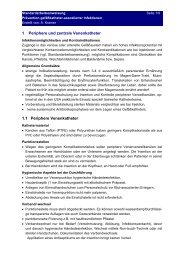
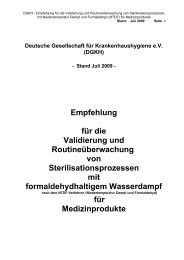


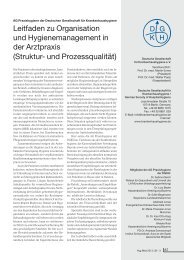

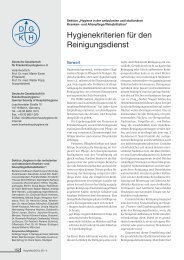


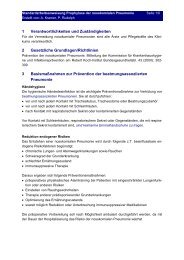

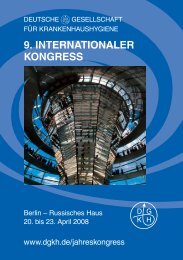
![Hauptprogramm [A4-Quer] - Deutsche Gesellschaft für ...](https://img.yumpu.com/6449478/1/184x260/hauptprogramm-a4-quer-deutsche-gesellschaft-fur-.jpg?quality=85)
